
The human body has just upped its official organ count. Researchers have recently proposed that the mesentery, a membrane in the digestive system, deserves to be considered an organ in its own right.
This means that humans are stuffed with a total of 79 organs.
To earn the title of organ, a body part must be self-contained and perform a critical function. Scientists have long thought the mesentery—which anchors the gut in place, connecting it to the wall of the abdomen—was made of multiple pieces (although Leonardo da Vinci sketched it as a single structure, because apparently he just had to be good at everything).
But in 2012, surgeons at the University of Limerick in Ireland found the mesentery to be one continuous fold of tissue after all, making it eligible for true organ status. The team compiled more evidence and has made the case for the mesentery’s upgrade to organhood in the November 2016 issue of The Lancet Gastroenterology & Hepatology.
Now that researchers have a better picture of the mesentery, they can learn more about what it does and how it might be involved in disease. This could lead to less invasive abdominal surgeries.
But your belly isn’t the only source of mysterious organs. From the brain to the genitals, our bodies host bits that have remained hidden or misunderstood for much of history. Here are five other body parts we’ve only recently started to grok:

Anterolateral ligament (knee)
A part of the knee that medical science ignored for nearly a century might be involved in a common sports injury.
Back in 1879, French surgeon Paul Segond noticed a “pearly, resistant, fibrous band” in the knee. This particularly ligament (a kind of tough tissue that hold bones together) was mostly forgotten until the 1970s, and then was mentioned only rarely, its form and purpose hazy. Deciding to clear up “the mystery surrounding this enigmatic structure,” surgeons in Belgium finally investigated and properly identified the perplexing ligament in 2013.
They found that the band—now called the anterolateral ligament or ALL—lies on the front of the knee, connecting the thighbone and shinbone, and is distinct from the four other ligaments that help stabilize the joint. The ALL might help protect the knee as we twist and change direction.
Some people have trouble recovering from a torn anterior cruciate ligament (ACL), an injury that often befalls athletes in sports that involve a lot of pivoting, like soccer or football. The surgeons who described the ALL suspect that this is because this fifth, poorly-understood knee ligament is often injured in tandem with the ACL. When patients don't respond well to treatment, it could be that their ALL is still torn.

Vertical occipital fasciculus (brain)
Yet another body part that history forgot was revived several years ago. In 2012, researchers spied a fiber pathway in the brain that seemed to be involved in reading, but couldn’t find any descriptions of it in modern medical literature.
After hitting the library, they finally tracked down its discoverer: German neurologist Carl Wernicke, famous for identifying Wernicke’s area (which helps us understand language). But apart from Wernicke’s drawings in an 1881 brain atlas, the team found only rare mentions of the brain area, now called the vertical occipital fasciculus (VOF).
The VOF’s disappearing act might have been spurred by a disagreement between Wernicke and his mentor, neuroanatomist Theodor Meynert. Meynert believed that neural pathways traveled from front to back through the brain, but the VOF moves up and down. Whether because the bundle of nerve fibers contradicted his beliefs or simply because of lack of interest, Meynert ignored the new discovery. The VOF might also have been a victim of bad communication; a few other scientists noticed it but called it something else, which made it difficult for researchers to gather a growing body of knowledge on the structure.
After rediscovering the VOF, Jason Yeatman of the University of Washington and his colleagues pinpointed its location with MRI scans. "It connects the regions of the brain that are important for perceiving forms—like recognizing a friend's face or reading a word—with the regions that help you move your eyes and focus on a particular place in space," he told the Washington Post.
This link is pretty important—people who sustain damage to the VOF can lose the ability to recognize words and read, according to case studies from the 1970s.

Dua’s layer (eye)
Your body isn’t exactly a trove of secret organs. But every now and again scientists do stumble upon a previously unknown body part. One was found hiding in the cornea—the clear, dome-shaped tissue that protects your eyeballs and focuses light—in 2013. The newly-identified Dua’s layer is tough but only 15 microns thick, and joins five previously known layers in the cornea. Harminder Dua of the University of Nottingham in England and his colleagues found the tissue by simulating corneal grafts and transplants in donated eyes. The team injected air bubbles into the corneas to lift the layers apart so they could be scanned with an electron microscope.
Dua’s layer might be involved in diseases that affect the back of the cornea. And understanding this tiny piece of the eye may make surgeries simpler and safer. Since Dua’s layer is stronger than other parts of the cornea, injecting air bubbles near it during surgery might be less likely to cause damage.

Brain lymphatic vessels
Our body is shot through with tiny pipes called lymphatic vessels that ferry immune cells to fight infection and remove waste such as dead cells. For centuries, scientists have assumed that only the brain lacks this direct connection to the immune system. But it turns out the brain isn’t so special after all—in 2015, two different labs finally discovered lymphatic vessels in the brain’s meninges, or protective covering. The vessels help drain fluid into nearby lymph nodes, and may explain how immune cells enter and exit the central nervous system.
A team at the University of Virginia noticed the microscopic vessels while examining mouse meninges, and then found similar structures in human brain samples. Soon after, scientists in Europe spied the vessels as well.
These critical vessels may have stayed out of sight for so long because they are so tiny and hide behind a major blood vessel, revealed at last thanks to recent advances in microscopy.
Mapping the brain’s lymphatic vessels might help us understand diseases such as Alzheimer’s and multiple sclerosis, which involve both the brain and the immune system.

Clitoris
This agent of female sexual pleasure is one of the body’s most misunderstood organs. We now know that there’s much more to the clitoris than meets the eye. The sensitive nub, or glans, with its “generous supply” of nerve endings, is only the outer part; most of the clitoris is internal, with tiny legs up to five inches that hug the vagina.
But the clitoris has long been shrouded in confusion (and the clitoral hood, which covers the glans). As the Huffington Post chronicled, the clitoris was maligned as “the devil’s teat” on witches (in 1486) and a site of immature orgasms (by Sigmund Freud, who believed that it must yield its pleasure-making status to the vagina after puberty).
Over time, the clitoris’s function and full structure have been discovered, lost, and then found again. “What constituted the clitoris, what it was called, what characterized normal anatomy and whether having a clitoris at all was normal were controversial issues,” urologist Helen O’Connell and her colleagues wrote in 2005.
Only recently has the clitoris started getting some love from science. Biologist Alfred Kinsey and sex researchers William Masters and Virginia Johnson began investigating its role in the latter half of the 20th century. Though sketched by anatomists centuries earlier, the extent of the clitoris wasn’t revealed until O’Connell and her team undertook dissections in 1998, and it got first 3D ultrasound in 2009.


0 comments: